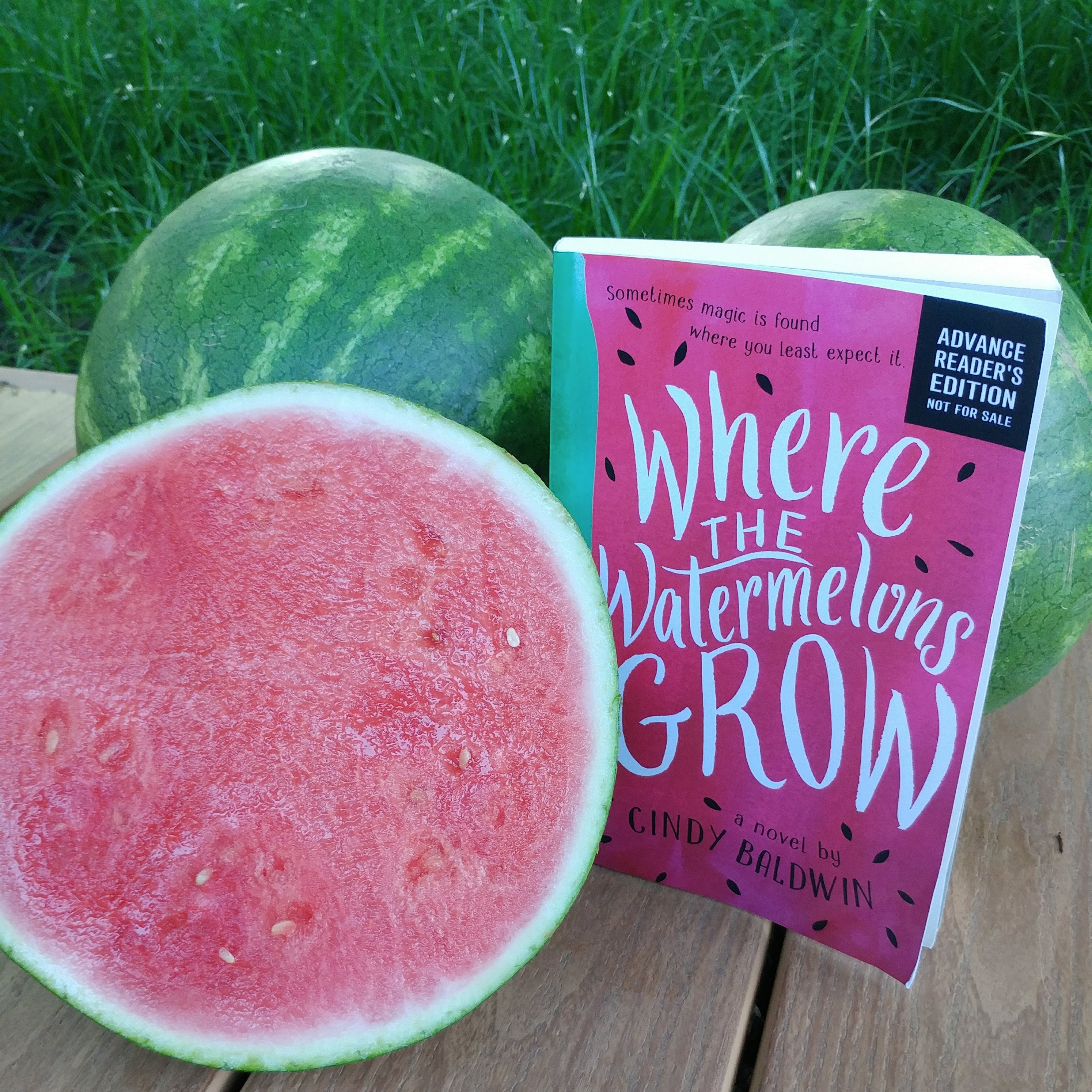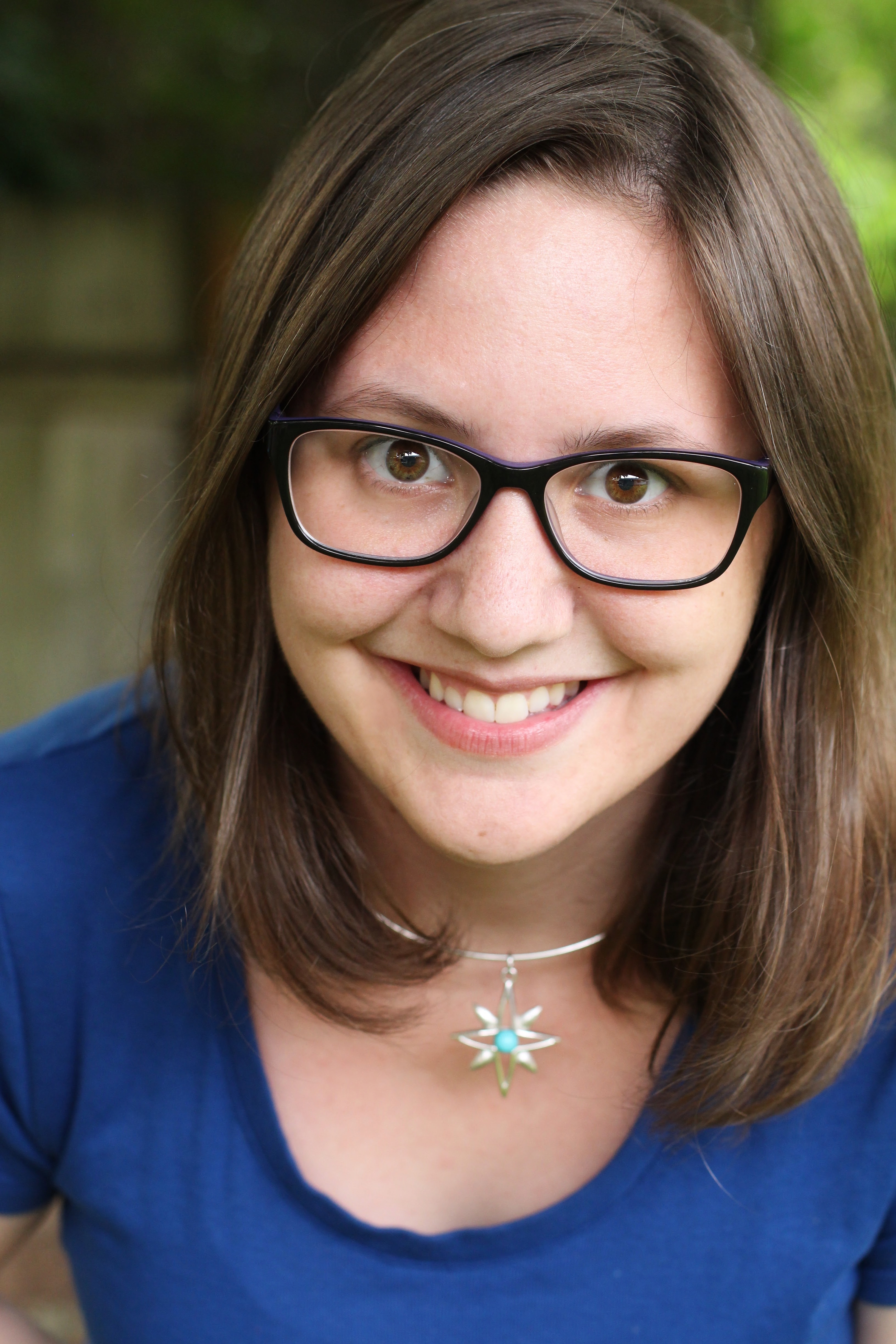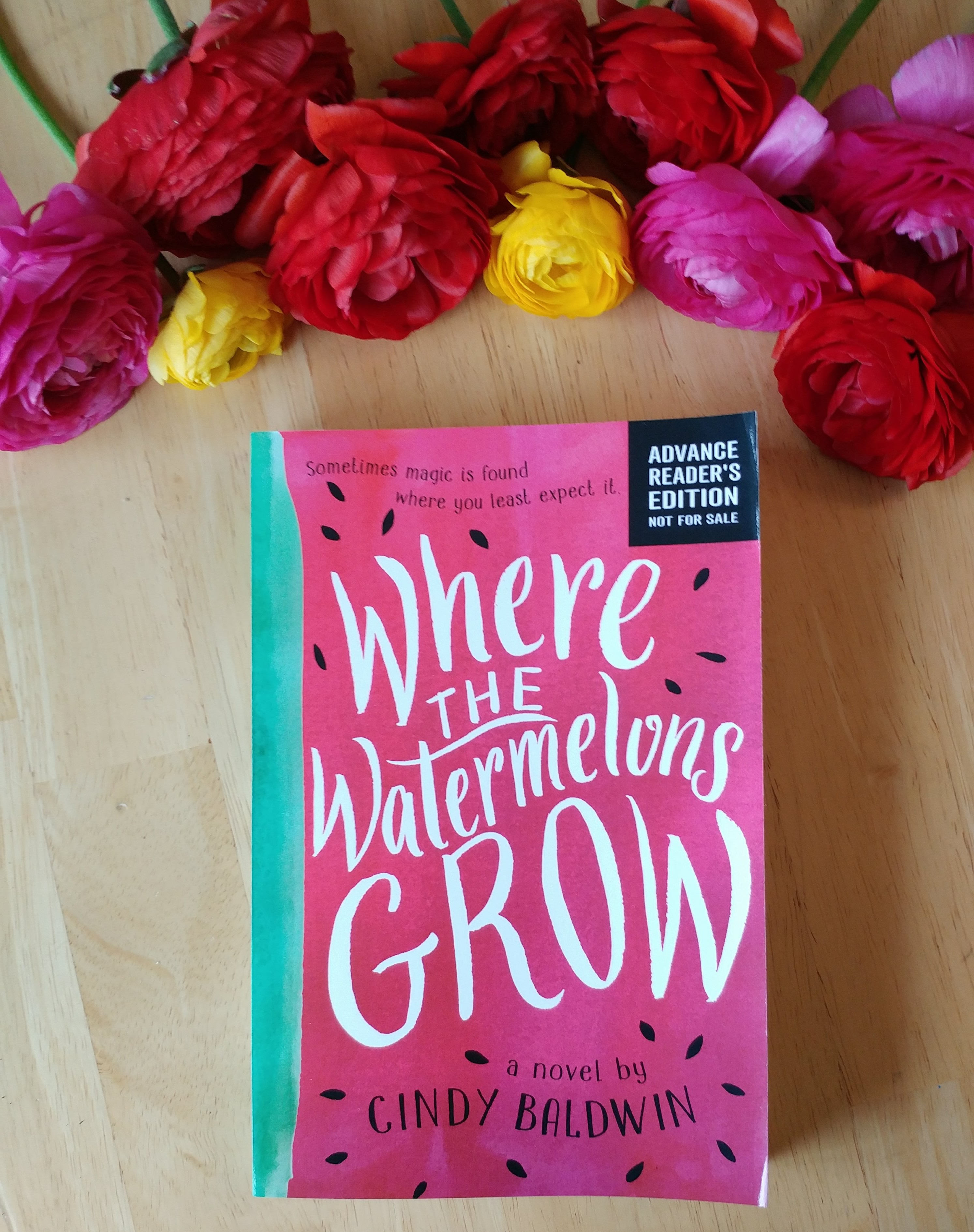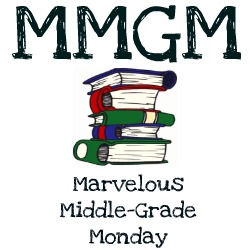Summer is here, and so is the heat! As I type this post I am–fittingly enough–munching on watermelon and wondering if the thunderstorms will hold off this afternoon so we can swim. And in my head I can hear Della’s voice from Where the Watermelons Grow, praying for rain and relief, as she and the rest of her town sizzle in the sun.

Having been friends with Cindy for a very long time now, I am so excited to see her lovely debut go out in the world! Today I am thrilled to share with you all an inside peak at the creation of this delightful new novel through an interview with Cindy Baldwin, as well as a chance to win your very own copy!

SW: Tell us about your writing journey, and how Where the Watermelons Grow came to be published!
CB: Like many writers, I was working at writing for a long time before getting a publishing deal! WATERMELONS is actually my 5th novel, and the 3rd that I queried to agents. The 2nd novel I queried was especially hard; I spent over a year racking up more than 100 rejections for that one, and felt like I was perpetually trapped in the land of “close but no cigar.” I had a LOT of near misses, but no offers. By the time I shelved that manuscript, I was so depressed about everything writing-related that I was really tempted to quit writing novels for good. Since I’d finished the whole first draft of WATERMELONS and gotten CP feedback on it, I decided I would go ahead and revise it and query it, but if it didn’t get picked up, I was quitting, at least for the foreseeable future.After a few rounds of revision, I started querying it in March of 2016. About two weeks later, I entered the first #DVPit contest, a Twitter Pitch party created by agent Beth Phelan to spotlight marginalized creators writing books that deal with marginalized characters. (Although I don’t have schizophrenia, I, like the mama in WATERMELONS, am disabled.) From there, everything went REALLY fast! I’d entered pitch contests with previous books without much success, so it was a huge shock to me when my phone suddenly blew up with notifications telling me I had a lot of agent and editor requests! The next two weeks were a whirlwind. Within about four days of the contest, I had my first offer, and a week and a half after that, I’d racked up a lot more offers, as well. It was SUCH a hard choice, and I had offers from some truly stellar agents, but ultimately I felt like my agent, Elizabeth Harding, most aligned with my vision for the story. We did a fairly quick round of revision after I signed with her and sent the book on submission about a month later. By the first week of July, I had accepted an offer of publication from HarperCollins! It still sometimes makes me feel dizzy, because I went from being the girl with 120+ rejections to the girl with multiple agent offers and a pretty fast book deal. This business really can change on a dime!
SW: That’s such a great story–I think I can speak for most authors in saying that hearing how hard luck can turn into beautiful dreams is the best encouragement! Speaking of hard times, I loved the way the drought and Della’s family dealing with the weather impacts your book! Can you talk about your decision to set the book against that backdrop? Is there a record of a drought like that in this part of NC?
CB: So, the drought and the weather are one of my favorite parts of the book! In early 2015, when I was just starting to outline the story, I took a class at the Storymakers conference with Martine Leavitt, who teaches at Vermont College of Fine Arts. During the class, Martine briefly talked about something I’d never heard of before called the “objective correlative” – a way to communicate, and induce emotion in the reader, without ever naming the emotion or stating what the character is feeling. I like to think of it as a grand-scale metaphor. (For any readers who are interested, I have a blog post about objective correlatives here, and author Rosalyn Eves has a more in-depth one here.) I was really intrigued by the idea, and decided right away that I wanted to have an objective correlative in WATERMELONS that went all the way through the book. Since I’d already decided on the Maryville drought as a plot device to increase tension in the story, I figured I’d use that. From then on, every time Della was feeling overwhelmed or anxious, instead of telling the reader that, I’d describe how oppressive the heat and the drought were! It worked really well as a metaphor, since Della is desperately wanting something that isn’t happening (her mother’s health), just like all the farmers of Maryville are desperately wanting rain to save their farms. I didn’t base the drought on a specific historical drought in eastern NC, but there definitely are periodic droughts throughout North Carolina that cause similar stresses. One year when I was in college, there was a drought in my hometown so severe that my family – we lived kind of in the country, away from city water – woke up every morning wondering if this would be the day our well ran dry!
SW: I think I remember that drought! Thanks so much for those links, I’ve heard of these concepts so I’m interested in learning more. I confess, given my awareness of your struggles with Cystic Fibrosis, when I heard that your book featured a daughter coming to terms with her mother’s illness I assumed the illness would be CF. Can you tell us how it came to be that you wrote about schizophrenia? What was your research process like, and did you use sensitivity readers?
CB: When I started writing the book, I really wanted to explore disability in a way I hadn’t really seen done before in middle grade – showing that disability experiences can be difficult, but also are absolutely compatible with healthy, loving, rich lives, and that disabled people are deserving of just as much love and respect as anybody else. I wasn’t ready to write about CF, though; in fact, I’ve spent years struggling with how to approach that particular topic in fiction and I’m only just getting to the point where I feel brave enough to try. Spotlighting an illness that has a similarly large effect on a family’s life but is also very different from my own was a way to delve into the themes and ideas I had spinning around in my head, without it being too emotionally difficult for me to handle when I wasn’t ready for it.I spent a lot of time researching both before and as I wrote the book. I read firsthand perspectives from patients, psychologists, and family members, as well as studying things like the impact of pregnancy and postpartum hormones on serious mental illnesses like schizophrenia. I was also able to interview some friends about their experiences with things like involuntary hospital commitment and antipsychotic use. I did have a lot of sensitivity readers, both before and after the book was accepted for publication. I tried to get a pretty good cross-section of sensitivity readers, as well – both those who had major mental illnesses themselves, those who were the children of mentally ill mothers, and those who both had major mental illness AND mentally ill mothers. Their perspectives were so helpful, especially in shaping the emotional components of Della’s reactions to her mother’s disease.
SW: I can readily see how writing about CF itself would be difficult–and am glad you found a way to explore these challenges anyway! It was wonderful the way the Kelly family felt real as real, like anyone else I know. I felt a deep sympathy for Della and her baby sister Mylie, in particular. Did you know who the girls would be before you started writing, or did you discover them during the process?
CB: I always had a very clear picture of Della, and her voice came to me really strongly as I planned the book and wrote. I didn’t plan Mylie before I wrote the first chapter, but she also came very naturally. At the time that I was writing this book, my own extremely high-strung daughter was deep in the terrible twos, and a lot of the inspiration for Mylie came right from real things my daughter did! In one scene, for instance, Mylie dumps dirt all over berries Della has been picking, ruining the whole bunch – that really happened. Mylie’s propensity for stealing and hiding important objects is also 100% based on my little girl. From about one to three, we called her “kleptobaby,” because she had a habit of stealing things and then hiding them in places we would NEVER FIND THEM. Once, we had her carseat all taken apart to clean it, and she stole the buckles off it and squirreled them away who knows where. We literally had to buy a new carseat because we never found them!!! I was sure when we moved away from the house we were living in, we’d find a stash of things Kate had taken, but we never did. Years later my husband and I STILL discuss it – like, where could she have taken all those things?! We didn’t have any vents in the floor, and our trash can had a lock on it. It’s a total mystery!
CB: Right now, I’m waiting for edits on my next middle grade book, which is currently scheduled for publication in fall 2019. I can’t share details about it yet, but it’s also set in NC – my hometown, actually! – and, like WATERMELONS, features a girl struggling with some tough stuff as well as elements of inexplicable magic. I’m also currently drafting another middle grade, which I’m head-over-heels in love with; it’s set in the mountains of NC, and I think of it as STARDUST meets LITTLE WOMEN for a middle grade audience. I can’t wait to see where that one goes!As for the Kelly family, the jury remains out on that one. I think Della’s story is over for now, but I’ve tossed around some ideas for a book featuring her best friend, Arden. We’ll see if those go anywhere!
I’m already intrigued by a pairing of Stardust meets Little Women, and can’t wait to hear more about your next book! Finally, to finish off our interview, Apricot-kitty has a question for you:
A: All those bee stories, and the thread of honey all through the book. Do you believe in magic? Because cats know something of magic, but most humans miss it. How is it you can see it?
CB: I was lucky enough to grow up, like Della, with lots of wonderful women who mentored and supported me. I’m also lucky that my daughter has the same kind of support system – so many other mothers who step up to help me out when I’m too sick to be everything she needs me to be. All of these experiences, and more, have taught me about the powerful, particular kind of magic that can come from love and community, helping us to find the strength inside us when we feel like it’s all gone. I may not always be the best at recognizing or accepting that help – but when I’m able to, the magic that results is more wonderful even than Miss Tabitha’s honey!
Thank you so much for this wonderful interview, Cindy! I’ve really enjoyed learning about the making of Where the Watermelons Grow, and hope my readers have, too. You all can find Cindy on twitter, her website, and instagram, and Where the Watermelons Grow is available for preorder from Amazon, Indiebound, B&N and elsewhere!
Cindy has generously offered one autographed copy of Where the Watermelons Grow to a lucky reader, to be sent out after her book launch on July 3rd.

To enter to win, simply comment below saying you’d like to win a copy and provide me your email address so I can contact you if you win, and have an address within the continental United States. For extra chances to win, tweet about the giveaway, follow Cindy on twitter, or subscribe to my blog and mention that in the comments as well.
*EDITED TO ADD: Giveaway will close on June 16th at midnight EST, and the winner will be contacted privately as well as being announced here in June 18th’s MMGM post!*
For more Marvelous Middle Grade Monday reviews, spotlights, interviews and giveaways check out the round up on Greg Pattridge’s blog, and happy reading!

Shari Sawyers
Suzanne
Geg Pattridge
Suzanne
Carl
Suzanne
Danielle Hammelef
Suzanne
Rosalyn
Suzanne
Patricia Tilton
Suzanne
Cindy Baldwin
Carolyn Fraiser
Suzanne
Natalie Aguirre
Suzanne
Brona Addison
Suzanne
June McCrary Jacobs
Suzanne
Meg Richardson
Suzanne
C. Lee McKenzie
Suzanne
Lisa
Suzanne
Linda
Suzanne
Stacey Bene
Suzanne
Joanne R. Fritz
Suzanne
Cindy Baldwin
Kim Pitts